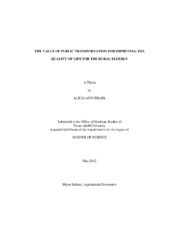| dc.description.abstract | Mobility is an undeniable issue for current and future elderly populations. The increasing popularity for retirees to live in rural communities makes this a particularly important issue in rural towns. When an elderly individual living in a rural community is no longer able to drive, issues that come with living in a rural area may be exacerbated, and the individual may experience a decrease in their quality of life. Although individuals may be able to use public transportation most existing options do not promote an independent lifestyle.
Any updated rural transportation system benefiting the elderly would be funded by taxpayers. An understanding of the taxpayers' preferences and willingness-to-pay (WTP) for transportation options, therefore, is essential. Few, if any economic studies have addressed this issue. The objectives of this research are to: (1) estimate economic willingness-to-pay (WTP) for public transportation options by using choice modeling techniques; and (2) better understand opinions related to public transportation for the elderly held by the general population as a whole and within different demographics. To complete these objectives, a choice survey was distributed to samples of three populations: residents of Atascosa County (located in south Texas); residents of Polk County (located in east Texas); and students at Texas A&M University. Respondents were presented with transportation options made of five attributes: addition to annual vehicle registration fee, days of operation, hours of operation, type of route, and senior citizen transportation fare discount.
Results show both students and the general public value public transportation options and are willing to pay for specific transportation attributes. Respondents tended to prefer options which are more flexible than the less flexible attribute presented to them; however, respondents did not necessarily prefer the most flexible options. Students, generally, are willing to pay more for transportation attributes than county residents. Overall, both Atascosa and Polk County residents have similar WTP's, indicating both populations value rural public transportation similarly. The effects of socio-demographic variables on residents' decision to choose a transportation option appear to differ between the counties. These findings imply that while the influence of transportation attribute levels are consistent across counties, local input is important in customizing transportation systems to meet local expectations. | en |


